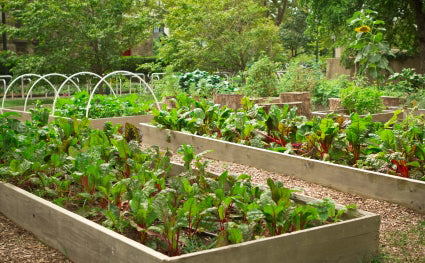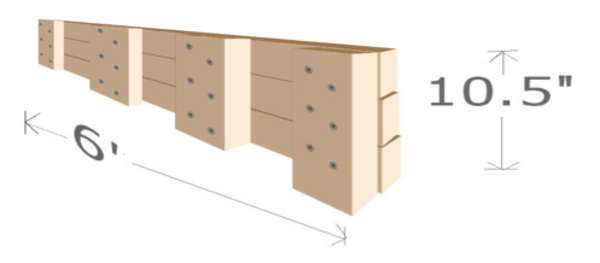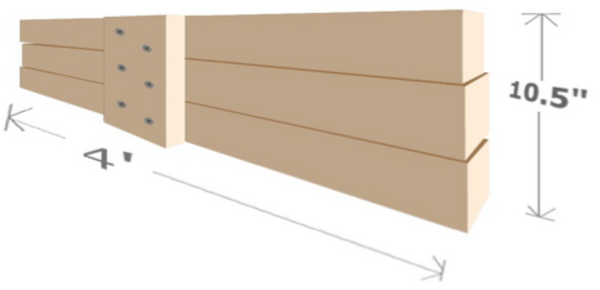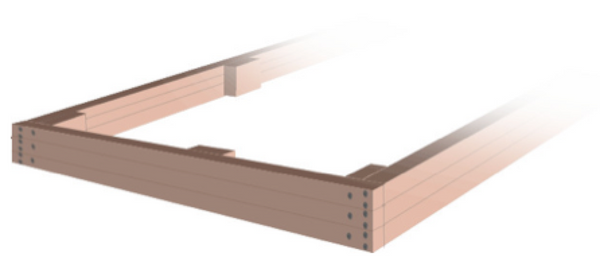
Raised Bed Construction and Planting Plans
Raised Bed Construction
Materials:
7, 2x4x10 lumber – redwood, cedar or wood alternative like Trex are best, these are most rot resistant and long lasting.
(DO NOT USE PRESSURE TREATED WOOD when growing edible plants)
2.5 inch self-tapping deck screws
4 ft. x 6 ft. 3 inch sheet of galvanized hardware cloth
20 cubic feet of planting mix for vegetables. (About 14, 1.5 c. ft. bags)
Large box of All-purpose granular vegetable fertilizer – Organic or conventional
Cut list:
Using 6 of the 2x4x10 lumber, cut so you have 6 – 4 ft. lengths for the endwalls, and 6 - 6 ft. lengths for the sidewalls
Using 1 of the 2x4x10 lumber, cut so you have 10 – 10.5 inch lengths to join the walls and corner
Tools:
Measuring tape
Safety glasses
Screw gun and bits (Hammer and nails are an alternative, but a screw gun makes the job much faster and easier.)
Staple gun and staples (1 box of 9/16” staples)
Wood clamps with at least a 12 inch opening
Hand saw or electric circular saw
Saw horses, or sturdy, flat surface for cutting wood
Metal cutting snips
Shovel Digging fork
Bow Rake
Construction Instructions
Step 1 – Build the 6 ft. sidewalls.
- Lay 3 of the 6 ft. 2x4s on a flat surface with the ends flush to each other, then clamp together.
- Put 10.5 inch pieces of 2x4 at each end, flush to ends, and 1 piece at each 3rd of the length (4 pieces total).
- Attach the 10.5 inch pieces with 2 screws at each section of the 2x4. (So each 10.5 inch piece will have 6 screws to join the wall together):

Step 2 – Build the 4 ft. endwalls.
- Lay 3 of the 4 ft. 2x4s on a flat surface with the ends flush to each other, clamp together.
- Put a 10.5 inch piece of 2x4 at center.
- Attach the 10.5 inch pieces with 2 screws at each section of the 2x4. (So each 10.5 inch piece will have 6 screws to join the endwall together:

Step 3 – Join sidewalls together to make the bed.
- Stand up the 4 endwalls; the 6 ft. sidewalls should line up on the insides of the 4 ft. endwalls.
- Put 3 screws at each section of 2x4 to join the corners together (each corner will have 9 screws total)

Step 4 – Attach hardware cloth to the bottom of the bed.
- Cut the hardware cloth so it measures 4 ft. x 6 ft. 3 inch, it should exactly meet the outside edge of the box.
- Lay the sheet of hardware cloth onto the bottom side of the box and attach with staples every 3 inches.
Step 5 – Site selection, and preparation.
Choose a site for your new bed that is flat and in full sun at least 8 hours a day. Make sure that you easily access it from all sides and that there is a spigot close by so you can hook up a hose that will easily reach to the bed.
- Remove any existing grass and weeds.
- Turn over soil thoroughly with a garden fork or shovel, breaking up the clods and moving all large stones.
- Rake the soil flat and even.
- Place the raised bed down onto the prepared site and fill with planting mix, adding enough so it mounds an inch or two above the top (it will quickly settle once planted and watered).
Planting Plans
-----TOP CONTENT ABOVE HERE-----
LEFT COLUMN CONTENT BELOW HERE
 Summer Planting Plan
Summer Planting Plan
with Seed Choices
LEFT COLUMN CONTENT ABOVE HERE
RIGHT COLUMN CONTENT BELOW HERE
 Spring Planting Plan
Spring Planting Plan
with Seed Choices
RIGHT COLUMN CONTENT ABOVE HERE
Raised Bed Construction
Materials:
7, 2x4x10 lumber – redwood, cedar or wood alternative like Trex are best, these are most rot resistant and long lasting.
(DO NOT USE PRESSURE TREATED WOOD when growing edible plants)
2.5 inch self-tapping deck screws
4 ft. x 6 ft. 3 inch sheet of galvanized hardware cloth
20 cubic feet of planting mix for vegetables. (About 14, 1.5 c. ft. bags)
Large box of All-purpose granular vegetable fertilizer – Organic or conventional
Cut list:
Using 6 of the 2x4x10 lumber, cut so you have 6 – 4 ft. lengths for the endwalls, and 6 - 6 ft. lengths for the sidewalls
Using 1 of the 2x4x10 lumber, cut so you have 10 – 10.5 inch lengths to join the walls and corner
Tools:
Measuring tape
Safety glasses
Screw gun and bits (Hammer and nails are an alternative, but a screw gun makes the job much faster and easier.)
Staple gun and staples (1 box of 9/16” staples)
Wood clamps with at least a 12 inch opening
Hand saw or electric circular saw
Saw horses, or sturdy, flat surface for cutting wood
Metal cutting snips
Shovel Digging fork
Bow Rake
Construction Instructions
Step 1 – Build the 6 ft. sidewalls.
- Lay 3 of the 6 ft. 2x4s on a flat surface with the ends flush to each other, then clamp together.
- Put 10.5 inch pieces of 2x4 at each end, flush to ends, and 1 piece at each 3rd of the length (4 pieces total).
- Attach the 10.5 inch pieces with 2 screws at each section of the 2x4. (So each 10.5 inch piece will have 6 screws to join the wall together):

Step 2 – Build the 4 ft. endwalls.
- Lay 3 of the 4 ft. 2x4s on a flat surface with the ends flush to each other, clamp together.
- Put a 10.5 inch piece of 2x4 at center.
- Attach the 10.5 inch pieces with 2 screws at each section of the 2x4. (So each 10.5 inch piece will have 6 screws to join the endwall together:

Step 3 – Join sidewalls together to make the bed.
- Stand up the 4 endwalls; the 6 ft. sidewalls should line up on the insides of the 4 ft. endwalls.
- Put 3 screws at each section of 2x4 to join the corners together (each corner will have 9 screws total)

Step 4 – Attach hardware cloth to the bottom of the bed.
- Cut the hardware cloth so it measures 4 ft. x 6 ft. 3 inch, it should exactly meet the outside edge of the box.
- Lay the sheet of hardware cloth onto the bottom side of the box and attach with staples every 3 inches.
Step 5 – Site selection, and preparation.
Choose a site for your new bed that is flat and in full sun at least 8 hours a day. Make sure that you easily access it from all sides and that there is a spigot close by so you can hook up a hose that will easily reach to the bed.
- Remove any existing grass and weeds.
- Turn over soil thoroughly with a garden fork or shovel, breaking up the clods and moving all large stones.
- Rake the soil flat and even.
- Place the raised bed down onto the prepared site and fill with planting mix, adding enough so it mounds an inch or two above the top (it will quickly settle once planted and watered).
Planting Plans
-----TOP CONTENT ABOVE HERE-----
LEFT COLUMN CONTENT BELOW HERE
 Summer Planting Plan
Summer Planting Plan
with Seed Choices
LEFT COLUMN CONTENT ABOVE HERE
RIGHT COLUMN CONTENT BELOW HERE
 Spring Planting Plan
Spring Planting Plan
with Seed Choices
RIGHT COLUMN CONTENT ABOVE HERE



